Clean energy for a penny
When will thermonuclear power stations appear? Scientists most often say something like “in 20 years we will solve all the fundamental questions”. Engineers from the nuclear industry talk about the second half of the 21st century. Politicians talk about the sea of clean energy for a penny, not bothering with dates. Economists say never.
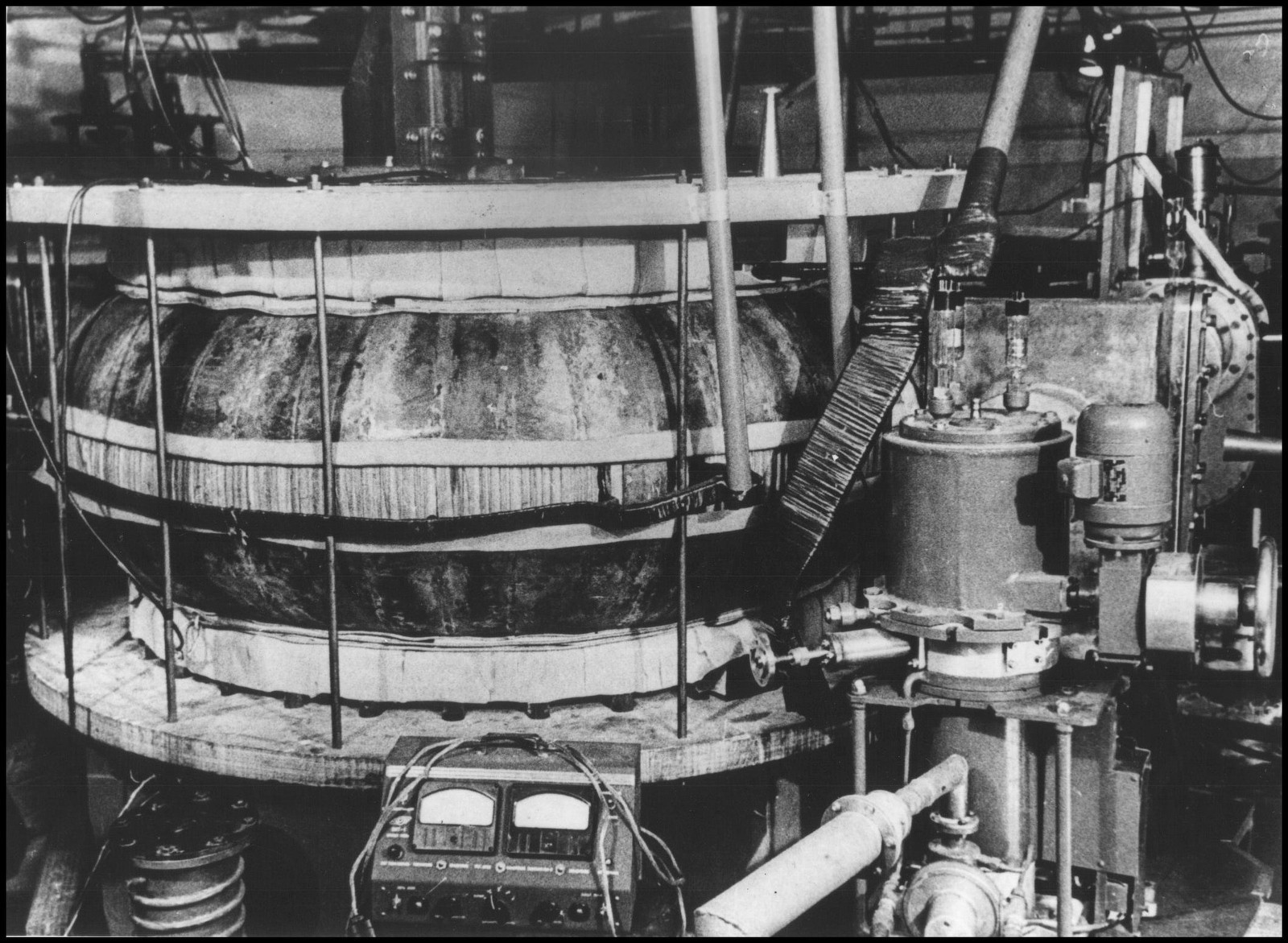
The creators of the world's first tokamak T-1 Artsimovich, Yavlinsky also promised power plants in 20 years.
People tend to make predictions by extrapolating experience. In the case of attempts to create a commercial thermonuclear power plant, the experience is negative - 60 years of effort led to a half-success - there is something, but this is clearly not something that can be used every day to generate electricity. Intuition says that if in 60 years we have not overcome this wall, then in the future we should not expect anything good.
And in vain. Because the amount of technology and knowledge is constantly growing, including the plasma and its retention. At some point, our knowledge will be enough to make thermonuclear energy possible in the usual and routine process of investing in the development of technology, without any special feats.
')
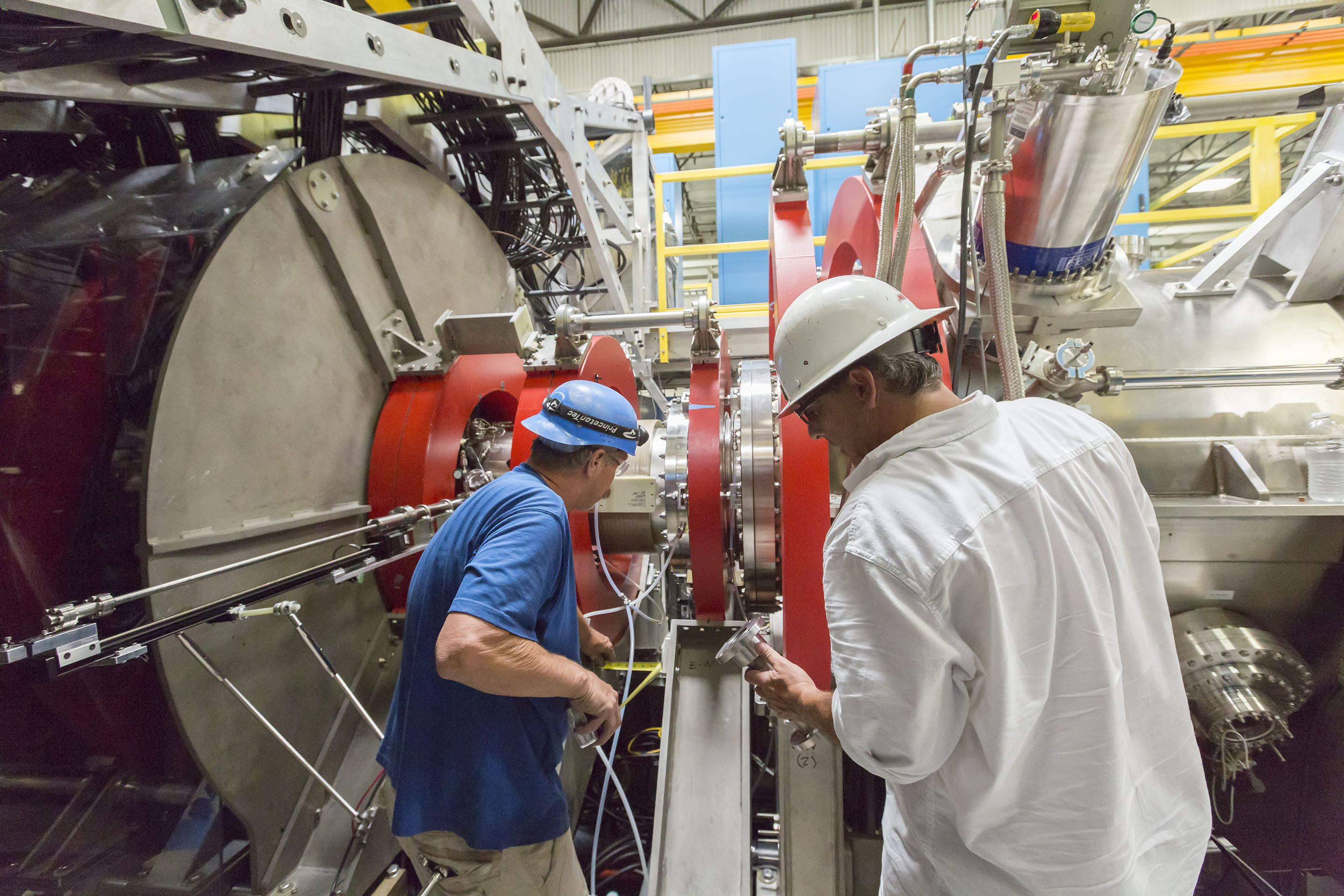
Here, for example, is a routine example of work on a Tri Alpha Energy C-2U unit.
On the way to this “possible” today psychological barriers stand in many ways. Too often, the developers of fusion reactors were faced with unpredictability, overestimated estimates, new unpleasant facts from the field of plasma physics. Too often, the way to deal with these facts led the concept to an economic deadlock, when two dozens of engineering miracles were screwed to a simple machine initially, and the resulting installation itself became a record solution that left no room for “ease of operation”, “reliability”, “ cheapness ”.
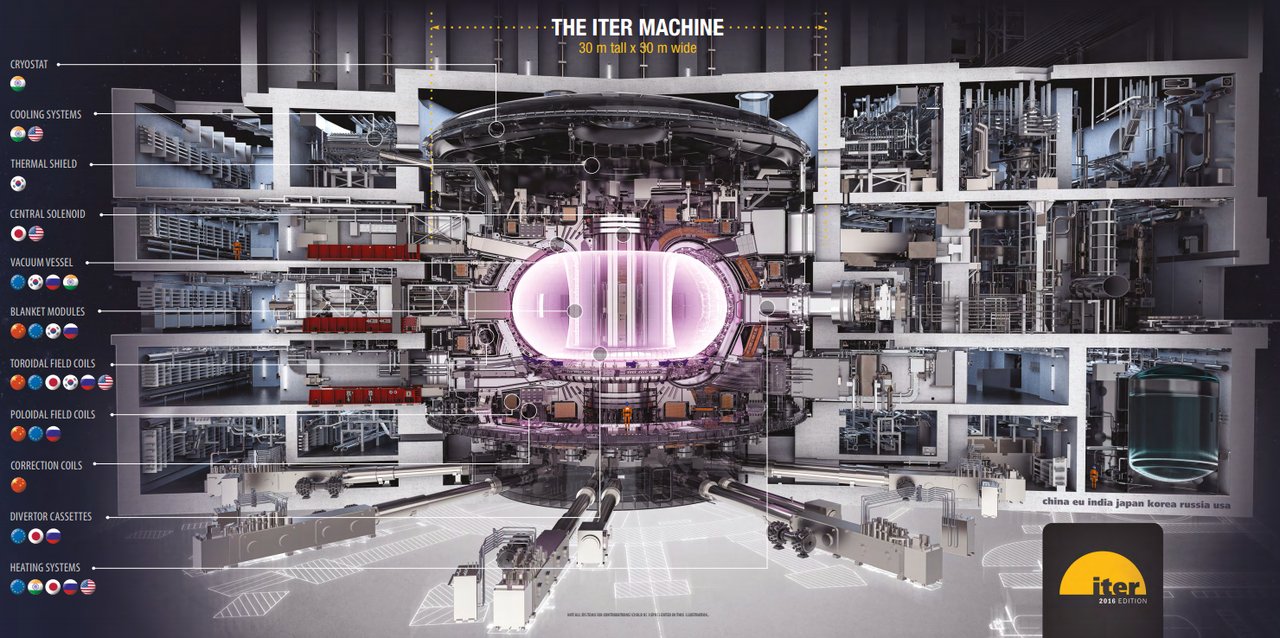
A luxurious ITER cut-out poster hints at the depth ofassholes the problems with the complexity of thermonuclear installations.
Against this background, it is very difficult to take responsibility for solving future, as yet unknown problems and to postulate that a fusion reactor can be built even if physics and engineering light a green light for the first time. What if with the growth of the reactor size a new unpleasant type of instability opens? What if the economy of yesterday's ingenious engineering finds that allow you to make a reactor turns out to be below the baseboard? What if the materials of a fusion reactor with an increase in the duration of work from 10 to 31000000 seconds will not withstand?

Official plans for Europe, even in a very optimistic way, promise a prototype thermonuclear power plant by 2050. Is it possible that someone will do it earlier?
Today, the Californian company Tri Alpha Energy (TAE) is psychologically closest to the construction of thermonuclear power stations. Here, a team of 150 people, among whom there are many famous plasmist physicists, are set in conditions when they have to show every 2-3 years a new achievement in the general outline of the movement towards a commercial fusion power plant. In fact, he made a plan for discoveries in the field of plasma physics. The downside of this pressure is the crazy pace of translating the ideas of scientists - its rather big experimental installation Tri Alpha can be easily upgraded a month after the emergence of new ideas - compare with the years for university and academic installations.
An interesting video from TAE - recovery picture of what is happening with the plasma in the installation of C-2U. Pay attention to the timer at the top left - it becomes clear that holding the plasma without disintegrating 8000 microseconds (current record) is quite long.
The idea behind the TAE reactor is to use plasma vortices (called FRC - Field Reversed Configuration), which have the property of self-holding and some other advantages, while maintaining their stability using neutral beam injectors, is quite fresh - from the middle of 90. Anyway it's newer than the ideas of a tokamak, stellarator, or classic open trap. FRCs have a rather unusual set of properties that in such a reactor it is convenient to use the thermonuclear reaction H 1 + B 11 = 3 * He 4 (H 1 here is ordinary hydrogen, B 11 is the most common isotope of boron, and He 4 are outgoing alpha particles, whence the name of the company Three Alpha). Paradoxically, this is one of the most difficult to achieve options for thermonuclear reaction - it requires temperatures 15 times higher than that of “classical” deuterium-tritium, and therefore 15 times greater magnetic field pressure to hold and more stringent purity requirements plasma

The speed of different thermonuclear reactions at the same density depending on temperature. Note that the scale on the left is logarithmic. At a temperature of 320 keV, pB11 hardly differs from DHe3 and is only several times slower than the classical DT.
However, FRCs allow using almost the entire magnitude of the magnetic field pressure, in contrast to tokamaks, where only 10% can be used. There are pB11 and pluses - both components are widely distributed and safe (unlike radioactive tritium and helium isotope He3, non-existent on Earth, and if tritium can be obtained from lithium at all, then He3 can only be mined somewhere in space) besides, the reaction does not produce powerful neutron radiation. For a DT reactor, neutron radiation carrying away 86% of thermonuclear reaction energy will be a real scourge, quickly destroying and activating structural materials. For pB11, the neutron power will be ~ 0.1% of the reactor power through side reactions.

The FRC itself is structured in the following way: the plasma in the external longitudinal field swirls in the form of a cylinder and maintains itself with its own field. This configuration tends to collapse quickly, but the founder of TAE suggested the idea of how this education can be maintained, and the TAE team has proven it to be correct.
Usually plasmists pay more attention to the extreme difficulty of obtaining plasma parameters needed for pB11 than to the substantial economic advantages of this reaction. Tritium and neutrons in the reactor are a huge burden, multiplying the cost and complicating the concept of the reactor, but not physicists to deal with these difficulties. On the other hand, a possible variant for the D + He3 reactions — almost also anaineutron (neutron power — 1–4% of reactor power) suffers from the need to build helium mining infrastructure parallel to power plants3, which today is an unreasonable occupation (for example, it can be mined). , how do you like this? Although someone will be unhappy that in the end we do not carry fuel from Uranus).

For investors, TAE is already drawing a preliminary look of a 380-megawatt (electrical) thermonuclear reactor. Plans - to build fifty such power plants in the 2030s
Hydrogen and Bor-11 are more available than nuclear power fuels — uranium 235 or plutonium 239.
Tri Alpha, gathering specialists at the level of the world's best fusion plasma research centers, is moving very fast. Only in 2015, it was shown that FRC vortices are supported, without disintegrating, with the help of powerful tangent beams of neutral particles - one of the key claims of the company's founder physicist Norman Rostoker. And now they are building a new facility, where a 30-fold increase in the triple parameter (the product of density, temperature, and confinement time — the main properties determining the energy output of a thermonuclear reaction) of a plasma should be achieved. If TAE again waits for success, this setup will allow you to grope the so-called scaling - an empirical dependence of the triple parameter on the installation characteristics (dimensions, magnetic field, power of neutral injectors, etc.). And scaling, in turn, will allow to determine with high accuracy whether it is possible to really make a reactor based on the idea of Tri Alpha, or it will be unattainable.

The machine assembled by TAE now - C2W will be equipped with 8 injectors of the neutral INP beam, and is capable of maintaining FRC with a temperature of 1-3 keV and thermonuclear density for ~ 30 milliseconds, the ability to work with hydrogen, deuterium and boron plasma.
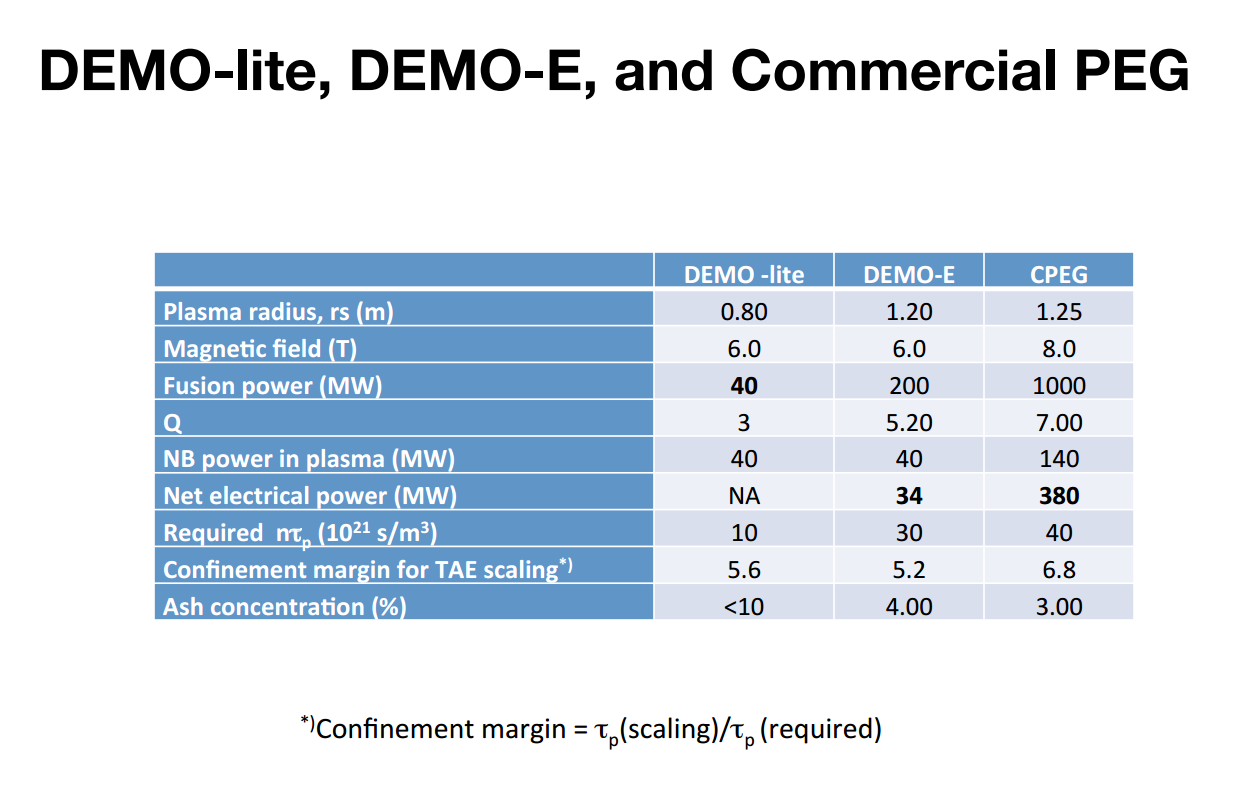
And these are far plans, the final installations of the line, already with a thermonuclear exit. Q here is one of the most difficult for pB11 parameters - the ratio of thermonuclear output to preheating.
Interestingly, on this path, nature, sometimes, throws up not only difficulties, but also gifts. For example, in all textbooks it is written that the hydrogen-boron thermonuclear reaction (p + B11 -> He4 + He4 + He4) in an optically transparent plasma will always lose more energy than it produces, i.e. to maintain it, external heating is needed — a path in the ideal case and a rather small ~ 15% of the power of the fusion reactor. This unpleasant characteristic of pB11 is quite easily calculated from the cross section (probability) of the reaction in the collision of a proton and boron ion and the calculation of electromagnetic losses in the scattering of hot electrons (and pB11 requires 20 times more temperature than the ITER reaction D + T-> He + n). So, new, more accurate measurements of the pB11 reaction cross section showed that the cross section is higher than previously thought. At certain temperatures, according to new data, thermonuclear fusion in this reaction emits more energy than is lost! It is interesting to see how physics textbooks are being rewritten.

New values of pB11 reaction cross sections depending on temperature (red).

And an amazing moment when it is necessary to rewrite the textbooks of physics - if before (blue dotted line) the energy output of the reaction was lower than the losses (red line) even in the theoretical version, now it is approximately equal to (blue line), and even a little more.
However, the distance that Tri Alpha needs to overcome is still very large - even if scaling is accurate, it is necessary to improve the quality of holding hundreds of times - the magnetic field pressure, power and the running time of the NBI and all other systems. The TAE team may well face the typical problem of thermonuclear installations — they become too large, complex, and move too slowly on their way to commercial reactors. Turning to the figures, I must say that now the record of the FRC temperature is slightly less than one thousand eV, and it is necessary - 320,000 eV. The energy retention time is a few milliseconds, and you need tens of seconds. The density is also at least ten times less than the parameters needed in an industrial installation. Some of this can be overcome simply by increasing the size and power of the reactor, but some will have to be increased qualitatively - by improving the purity of the plasma, the efficiency of the supporting systems, finding new, more successful, plasma modes.

Another artist's work on the possible appearance of future cars TAE.

A picture with an asterisk is a different version of the first Tri Alpha thermonuclear machine - with better and worse configs. The FRC retention time is from 7 to 30 seconds (not milliseconds!), FRC fuel supply systems, pumping out helium “ash”, which “burns the firebox”, new megavolt neutral beam injectors, now being developed by the Novosibirsk INP and good luck, will be needed the plasma has not thrown out the next forteli.
Tri Alpha plans to go this way (before the prototype of the power station) for 5 installations and about 15 years, and received about half a billion dollars from various investors for this work.

Photo from the inside of the already disassembled installation C-2U. By the way, the worker did not dress in such a way that everyone would understand his coolness, but not to leave organics on the inner walls of the chamber - the plasma is extremely sensitive to the quality of the vacuum and pollution, and one hair in the vacuum chamber may not give an experiment.
But I was not talking about psychology for nothing. While the TAE team is confidently eating through the eyes of investors, other specialists, who have repeatedly burned themselves on forecasts, speak more modestly about the current prospects for thermonuclear power engineering. Nevertheless, the latest theoretical ideas in the Institute of Nuclear Physics. Budker in Novosibirsk, if they are confirmed in the experiment, can greatly simplify the work on the creation of a thermonuclear reactor, greatly reducing its size and complexity.
Before I talk about them, I want to once again dwell on an interesting point. Imagine that for many decades you give thermonuclear physicists money for solid plans “a power station in 20 years,” and each time they come and say “the plasma turned out to be more complicated than we thought, we need another 20 years”. And here they come and say “the plasma was harder than we thought, so we had a simple and cheap solution, but we need 20 years”. What do you answer them? :)
So, we are talking about two so far theoretical, possible ideas - “diamagnetic bubble” and “plasma pumping with a helical magnetic field”. The first is that in an open trap to inflate a “bubble” from the plasma, due to which, in fact, to increase the amount of plasma and its pressure is the ideal direction of movement if we want to reduce energy losses from thermonuclear plasma. It would seem a trivial idea includes several tricky features, the understanding of which appeared in recent decades. Such a bubble can reduce the size of a fusion reactor in an open trap by ~ 10 times. An experimental test of this idea is expected in the next couple of years.
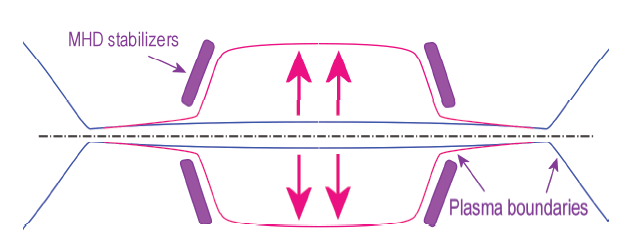
Bubble is really a bubble. The original plasma contour in the GDL trap is drawn with a blue line.
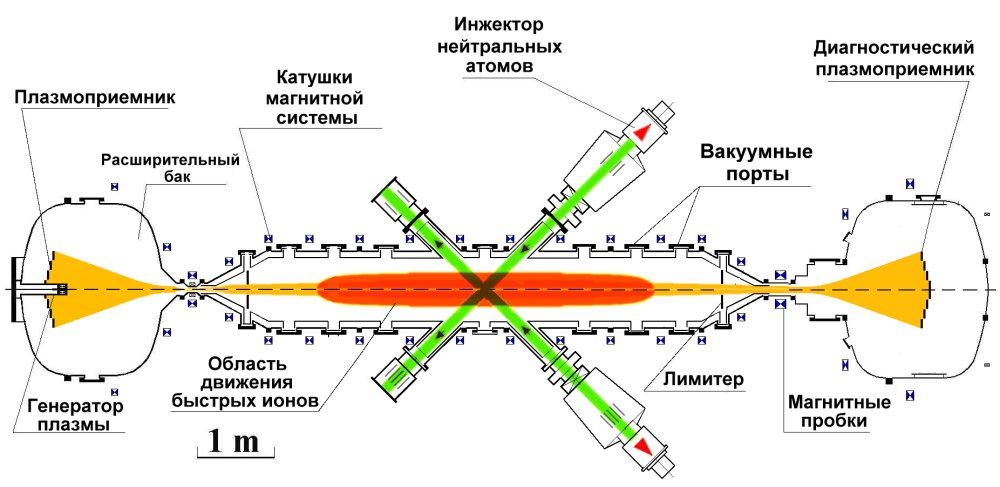
A schematic section of the GDL open trap, on the basis of which the idea of a “bubble” emerged, and to which a significant reduction in the size of the power reactor is applicable, if this idea works.
Since we started talking about open traps - let me remind you that this simplest version of the thermonuclear installation “did not go” at one time because of two main problems - instabilities, which we learned to fight only in the 21st century, when interest in traps was mostly lost and a large longitudinal thermal conductivity (i.e., the leakage of heat from the plasma through the holes at the end of the cylindrical installation - this is an open trap). The second problem has not been completely resolved today, therefore, instead of deuterium or boron, it is necessary to burn coal. So, “plasma pumping with a screw magnetic field” is a prototype of the magnetic system, which is installed at the open ends of the trap and “pumps” the plasma back, due to the interaction of the screw magnetic field with the plasma rotating around the axis, flying out. The effectiveness in suppressing the longitudinal thermal conductivity of such a system can turn out to be incredibly high, having solved the remaining fundamental problem of OL.

The schematic diagram of the installation of RESIN - on the left is a plasma gun, in the middle is a spiral magnetic system, on the left is an expander tank with a segmented electron that creates an electrical gradient in the plasma that twists it. The screw system can be included “along” and “against” the plasma.
The most interesting thing is that the installation of Pitch for checking the “screw hold” is already going to the INP, and perhaps in the spring of 2017 one can see the first results. Once again, for 50 years, this problem did not allow to take and build a thermonuclear reactor based on an open trap (to be fair - along with other physical issues and a lot of engineering still waiting ahead), and can be closed in a rather routine physical experiment next year.

The 1958 article on "Stellarator promising a significant leap in obtaining useful energy from controlled thermonuclear fusion."
Summing up, I will once again remember about psychology. People of the past 30 years have become accustomed to the idea that thermonuclear power engineering is at least economically unjustified, and possibly directly banned for engineering or physical reasons. They got used to the era when the progress of physicists on this path was half-hearted, and the proposed designs of fusion reactors were not viable. Now, perhaps, we are entering the next epoch, when we will have to wean from the fact that thermonuclear power stations are impossible. When rejected ideas 40 or even 60 years ago with a new understanding of plasma and technical capabilities (for example, superconductors or digital control systems) suddenly light up the green light.

The creators of the world's first tokamak T-1 Artsimovich, Yavlinsky also promised power plants in 20 years.
People tend to make predictions by extrapolating experience. In the case of attempts to create a commercial thermonuclear power plant, the experience is negative - 60 years of effort led to a half-success - there is something, but this is clearly not something that can be used every day to generate electricity. Intuition says that if in 60 years we have not overcome this wall, then in the future we should not expect anything good.
And in vain. Because the amount of technology and knowledge is constantly growing, including the plasma and its retention. At some point, our knowledge will be enough to make thermonuclear energy possible in the usual and routine process of investing in the development of technology, without any special feats.
')

Here, for example, is a routine example of work on a Tri Alpha Energy C-2U unit.
On the way to this “possible” today psychological barriers stand in many ways. Too often, the developers of fusion reactors were faced with unpredictability, overestimated estimates, new unpleasant facts from the field of plasma physics. Too often, the way to deal with these facts led the concept to an economic deadlock, when two dozens of engineering miracles were screwed to a simple machine initially, and the resulting installation itself became a record solution that left no room for “ease of operation”, “reliability”, “ cheapness ”.

A luxurious ITER cut-out poster hints at the depth of
Against this background, it is very difficult to take responsibility for solving future, as yet unknown problems and to postulate that a fusion reactor can be built even if physics and engineering light a green light for the first time. What if with the growth of the reactor size a new unpleasant type of instability opens? What if the economy of yesterday's ingenious engineering finds that allow you to make a reactor turns out to be below the baseboard? What if the materials of a fusion reactor with an increase in the duration of work from 10 to 31000000 seconds will not withstand?

Official plans for Europe, even in a very optimistic way, promise a prototype thermonuclear power plant by 2050. Is it possible that someone will do it earlier?
Today, the Californian company Tri Alpha Energy (TAE) is psychologically closest to the construction of thermonuclear power stations. Here, a team of 150 people, among whom there are many famous plasmist physicists, are set in conditions when they have to show every 2-3 years a new achievement in the general outline of the movement towards a commercial fusion power plant. In fact, he made a plan for discoveries in the field of plasma physics. The downside of this pressure is the crazy pace of translating the ideas of scientists - its rather big experimental installation Tri Alpha can be easily upgraded a month after the emergence of new ideas - compare with the years for university and academic installations.
An interesting video from TAE - recovery picture of what is happening with the plasma in the installation of C-2U. Pay attention to the timer at the top left - it becomes clear that holding the plasma without disintegrating 8000 microseconds (current record) is quite long.
The idea behind the TAE reactor is to use plasma vortices (called FRC - Field Reversed Configuration), which have the property of self-holding and some other advantages, while maintaining their stability using neutral beam injectors, is quite fresh - from the middle of 90. Anyway it's newer than the ideas of a tokamak, stellarator, or classic open trap. FRCs have a rather unusual set of properties that in such a reactor it is convenient to use the thermonuclear reaction H 1 + B 11 = 3 * He 4 (H 1 here is ordinary hydrogen, B 11 is the most common isotope of boron, and He 4 are outgoing alpha particles, whence the name of the company Three Alpha). Paradoxically, this is one of the most difficult to achieve options for thermonuclear reaction - it requires temperatures 15 times higher than that of “classical” deuterium-tritium, and therefore 15 times greater magnetic field pressure to hold and more stringent purity requirements plasma

The speed of different thermonuclear reactions at the same density depending on temperature. Note that the scale on the left is logarithmic. At a temperature of 320 keV, pB11 hardly differs from DHe3 and is only several times slower than the classical DT.
However, FRCs allow using almost the entire magnitude of the magnetic field pressure, in contrast to tokamaks, where only 10% can be used. There are pB11 and pluses - both components are widely distributed and safe (unlike radioactive tritium and helium isotope He3, non-existent on Earth, and if tritium can be obtained from lithium at all, then He3 can only be mined somewhere in space) besides, the reaction does not produce powerful neutron radiation. For a DT reactor, neutron radiation carrying away 86% of thermonuclear reaction energy will be a real scourge, quickly destroying and activating structural materials. For pB11, the neutron power will be ~ 0.1% of the reactor power through side reactions.

The FRC itself is structured in the following way: the plasma in the external longitudinal field swirls in the form of a cylinder and maintains itself with its own field. This configuration tends to collapse quickly, but the founder of TAE suggested the idea of how this education can be maintained, and the TAE team has proven it to be correct.
Usually plasmists pay more attention to the extreme difficulty of obtaining plasma parameters needed for pB11 than to the substantial economic advantages of this reaction. Tritium and neutrons in the reactor are a huge burden, multiplying the cost and complicating the concept of the reactor, but not physicists to deal with these difficulties. On the other hand, a possible variant for the D + He3 reactions — almost also anaineutron (neutron power — 1–4% of reactor power) suffers from the need to build helium mining infrastructure parallel to power plants3, which today is an unreasonable occupation (for example, it can be mined). , how do you like this? Although someone will be unhappy that in the end we do not carry fuel from Uranus).

For investors, TAE is already drawing a preliminary look of a 380-megawatt (electrical) thermonuclear reactor. Plans - to build fifty such power plants in the 2030s
Hydrogen and Bor-11 are more available than nuclear power fuels — uranium 235 or plutonium 239.
Tri Alpha, gathering specialists at the level of the world's best fusion plasma research centers, is moving very fast. Only in 2015, it was shown that FRC vortices are supported, without disintegrating, with the help of powerful tangent beams of neutral particles - one of the key claims of the company's founder physicist Norman Rostoker. And now they are building a new facility, where a 30-fold increase in the triple parameter (the product of density, temperature, and confinement time — the main properties determining the energy output of a thermonuclear reaction) of a plasma should be achieved. If TAE again waits for success, this setup will allow you to grope the so-called scaling - an empirical dependence of the triple parameter on the installation characteristics (dimensions, magnetic field, power of neutral injectors, etc.). And scaling, in turn, will allow to determine with high accuracy whether it is possible to really make a reactor based on the idea of Tri Alpha, or it will be unattainable.

The machine assembled by TAE now - C2W will be equipped with 8 injectors of the neutral INP beam, and is capable of maintaining FRC with a temperature of 1-3 keV and thermonuclear density for ~ 30 milliseconds, the ability to work with hydrogen, deuterium and boron plasma.

And these are far plans, the final installations of the line, already with a thermonuclear exit. Q here is one of the most difficult for pB11 parameters - the ratio of thermonuclear output to preheating.
Interestingly, on this path, nature, sometimes, throws up not only difficulties, but also gifts. For example, in all textbooks it is written that the hydrogen-boron thermonuclear reaction (p + B11 -> He4 + He4 + He4) in an optically transparent plasma will always lose more energy than it produces, i.e. to maintain it, external heating is needed — a path in the ideal case and a rather small ~ 15% of the power of the fusion reactor. This unpleasant characteristic of pB11 is quite easily calculated from the cross section (probability) of the reaction in the collision of a proton and boron ion and the calculation of electromagnetic losses in the scattering of hot electrons (and pB11 requires 20 times more temperature than the ITER reaction D + T-> He + n). So, new, more accurate measurements of the pB11 reaction cross section showed that the cross section is higher than previously thought. At certain temperatures, according to new data, thermonuclear fusion in this reaction emits more energy than is lost! It is interesting to see how physics textbooks are being rewritten.

New values of pB11 reaction cross sections depending on temperature (red).

And an amazing moment when it is necessary to rewrite the textbooks of physics - if before (blue dotted line) the energy output of the reaction was lower than the losses (red line) even in the theoretical version, now it is approximately equal to (blue line), and even a little more.
However, the distance that Tri Alpha needs to overcome is still very large - even if scaling is accurate, it is necessary to improve the quality of holding hundreds of times - the magnetic field pressure, power and the running time of the NBI and all other systems. The TAE team may well face the typical problem of thermonuclear installations — they become too large, complex, and move too slowly on their way to commercial reactors. Turning to the figures, I must say that now the record of the FRC temperature is slightly less than one thousand eV, and it is necessary - 320,000 eV. The energy retention time is a few milliseconds, and you need tens of seconds. The density is also at least ten times less than the parameters needed in an industrial installation. Some of this can be overcome simply by increasing the size and power of the reactor, but some will have to be increased qualitatively - by improving the purity of the plasma, the efficiency of the supporting systems, finding new, more successful, plasma modes.

Another artist's work on the possible appearance of future cars TAE.

A picture with an asterisk is a different version of the first Tri Alpha thermonuclear machine - with better and worse configs. The FRC retention time is from 7 to 30 seconds (not milliseconds!), FRC fuel supply systems, pumping out helium “ash”, which “burns the firebox”, new megavolt neutral beam injectors, now being developed by the Novosibirsk INP and good luck, will be needed the plasma has not thrown out the next forteli.
Tri Alpha plans to go this way (before the prototype of the power station) for 5 installations and about 15 years, and received about half a billion dollars from various investors for this work.

Photo from the inside of the already disassembled installation C-2U. By the way, the worker did not dress in such a way that everyone would understand his coolness, but not to leave organics on the inner walls of the chamber - the plasma is extremely sensitive to the quality of the vacuum and pollution, and one hair in the vacuum chamber may not give an experiment.
But I was not talking about psychology for nothing. While the TAE team is confidently eating through the eyes of investors, other specialists, who have repeatedly burned themselves on forecasts, speak more modestly about the current prospects for thermonuclear power engineering. Nevertheless, the latest theoretical ideas in the Institute of Nuclear Physics. Budker in Novosibirsk, if they are confirmed in the experiment, can greatly simplify the work on the creation of a thermonuclear reactor, greatly reducing its size and complexity.
Before I talk about them, I want to once again dwell on an interesting point. Imagine that for many decades you give thermonuclear physicists money for solid plans “a power station in 20 years,” and each time they come and say “the plasma turned out to be more complicated than we thought, we need another 20 years”. And here they come and say “the plasma was harder than we thought, so we had a simple and cheap solution, but we need 20 years”. What do you answer them? :)
So, we are talking about two so far theoretical, possible ideas - “diamagnetic bubble” and “plasma pumping with a helical magnetic field”. The first is that in an open trap to inflate a “bubble” from the plasma, due to which, in fact, to increase the amount of plasma and its pressure is the ideal direction of movement if we want to reduce energy losses from thermonuclear plasma. It would seem a trivial idea includes several tricky features, the understanding of which appeared in recent decades. Such a bubble can reduce the size of a fusion reactor in an open trap by ~ 10 times. An experimental test of this idea is expected in the next couple of years.

Bubble is really a bubble. The original plasma contour in the GDL trap is drawn with a blue line.

A schematic section of the GDL open trap, on the basis of which the idea of a “bubble” emerged, and to which a significant reduction in the size of the power reactor is applicable, if this idea works.
Since we started talking about open traps - let me remind you that this simplest version of the thermonuclear installation “did not go” at one time because of two main problems - instabilities, which we learned to fight only in the 21st century, when interest in traps was mostly lost and a large longitudinal thermal conductivity (i.e., the leakage of heat from the plasma through the holes at the end of the cylindrical installation - this is an open trap). The second problem has not been completely resolved today, therefore, instead of deuterium or boron, it is necessary to burn coal. So, “plasma pumping with a screw magnetic field” is a prototype of the magnetic system, which is installed at the open ends of the trap and “pumps” the plasma back, due to the interaction of the screw magnetic field with the plasma rotating around the axis, flying out. The effectiveness in suppressing the longitudinal thermal conductivity of such a system can turn out to be incredibly high, having solved the remaining fundamental problem of OL.

The schematic diagram of the installation of RESIN - on the left is a plasma gun, in the middle is a spiral magnetic system, on the left is an expander tank with a segmented electron that creates an electrical gradient in the plasma that twists it. The screw system can be included “along” and “against” the plasma.
The most interesting thing is that the installation of Pitch for checking the “screw hold” is already going to the INP, and perhaps in the spring of 2017 one can see the first results. Once again, for 50 years, this problem did not allow to take and build a thermonuclear reactor based on an open trap (to be fair - along with other physical issues and a lot of engineering still waiting ahead), and can be closed in a rather routine physical experiment next year.

The 1958 article on "Stellarator promising a significant leap in obtaining useful energy from controlled thermonuclear fusion."
Summing up, I will once again remember about psychology. People of the past 30 years have become accustomed to the idea that thermonuclear power engineering is at least economically unjustified, and possibly directly banned for engineering or physical reasons. They got used to the era when the progress of physicists on this path was half-hearted, and the proposed designs of fusion reactors were not viable. Now, perhaps, we are entering the next epoch, when we will have to wean from the fact that thermonuclear power stations are impossible. When rejected ideas 40 or even 60 years ago with a new understanding of plasma and technical capabilities (for example, superconductors or digital control systems) suddenly light up the green light.
Source: https://habr.com/ru/post/397025/
All Articles